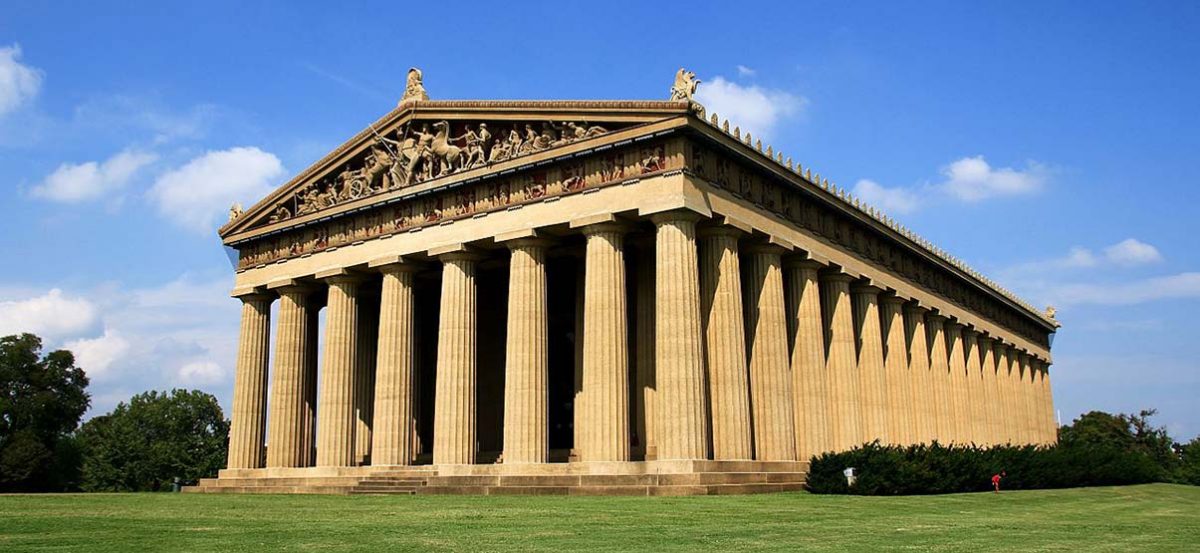
by Nanette Peraino
In the Bible Belt, known for conservative society and politics, prepare to be stunned, if not amazed at what Nashville, Tennessee serves up by way of a temple to a pagan goddess.
 Located in a densely populated area in midtown Nashville, you might be tempted to forego this classical attraction, but I highly recommend you reconsider. I wasn’t prepared to be drawn to this impressive classical structure, far less the massive tribute to a Greek Goddess. But once I approached the vaulting Doric structure, walked up the steps and stood gazing down a colonnade of grand architectural perspective, I knew I needed to explore everything the Nashville Parthenon had to offer.
Located in a densely populated area in midtown Nashville, you might be tempted to forego this classical attraction, but I highly recommend you reconsider. I wasn’t prepared to be drawn to this impressive classical structure, far less the massive tribute to a Greek Goddess. But once I approached the vaulting Doric structure, walked up the steps and stood gazing down a colonnade of grand architectural perspective, I knew I needed to explore everything the Nashville Parthenon had to offer.
Prepare to go back to a Golden Age in time as this classic structure and her embodied works; a replica of the original Athena on the upper level and on the lower level an impressive art collection – the Cowan Collection (as well as other local artists) as you leave the hustle and bustle of 21st century middle Tennessee behind.
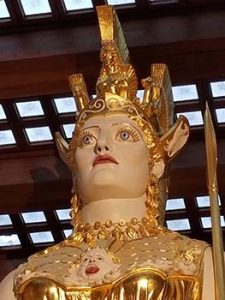 Your first impression of Athena might be that you wouldn’t let your 13 year old daughter out of the house made up like that. But don’t be put off. Her skin and makeup were painted to replicate the original Athena whose skin was of ivory and lips and eyes beset with jewels.
Your first impression of Athena might be that you wouldn’t let your 13 year old daughter out of the house made up like that. But don’t be put off. Her skin and makeup were painted to replicate the original Athena whose skin was of ivory and lips and eyes beset with jewels.
The Parthenon was originally constructed for the TN Centennial Expo in 1897 celebrating Tennessee’s entry into the union in 1796. Designed by confederate veteran William Crawford Smith, the Nashville Parthenon is the only full scale re-creation of the famous temple to the Greek Goddess Athena. The original was built in fifth century B.C.E. in Athens, Greece and now stands in ruins.
Centennial Park
Located in what is now called Centennial Park, the Parthenon (formerly the Fine Arts Building during the 1987 Expo) originally housed over 1,000 paintings and sculptures from around the world, with a large amount of space devoted to Tennessee artists.
Be sure to enjoy the James M. Cowan Collection on the lower level. That’s where you’ll feast your eyes on an impressive collection of oils on canvas, dating 1765-1923. Donated anonymously (his identity to be made known after his death) these sixty-three works are a permanent collection and celebrate American artists in a time when only European artists were recognised.
The Expo originally covered over two-hundred acres of what had been a horse racetrack. And originally included a bridge and gondola rides fashioned after the Rialto in Venice, Italy. Visitors from all over the country came to visit this grand attraction and brought in a much needed surge of economic activity.
The Athens of the South
By the time Nashville celebrated its one hundredth year of statehood, and because of its emphasis on private and public education, it had already earned the nickname “Athens of the South.” The early 19th century Greek revival architecture had reached national popularity in U.S. Government buildings, banks and even wealthy statesmen adopted “neo-classicism” as a design choice.
Although all the Expo buildings, including the Parthenon, were only intended as temporary structures (demo to commence after the end of the fair) Nashvillians protested and the Parthenon remained as an art exhibition site.
A contribution box was placed near sculptor Belle Kinney’s small model of Athena. Visitors and locals donated their small change and by 1982 $30,000 in seed money was raised to reconstruct a full-scale Athena.
The Athena Competition
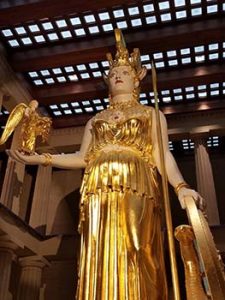 In 1982, sculptor and Nashville native, Alan LeQuire entered and won the Athena Competition. Unveiled in 1990, Athena was finally painted and fully gilded in 2002. Mr. LeQuire and Master Guilder Lou Reed covered Athena’s gown and armature in gold leaf. Her skin and features were painted to replicate the original Greek stylization of ivory for her skin and jewels for her eyes.
In 1982, sculptor and Nashville native, Alan LeQuire entered and won the Athena Competition. Unveiled in 1990, Athena was finally painted and fully gilded in 2002. Mr. LeQuire and Master Guilder Lou Reed covered Athena’s gown and armature in gold leaf. Her skin and features were painted to replicate the original Greek stylization of ivory for her skin and jewels for her eyes.
LeQuire’s Athena, the largest indoor statue in the western world, is built of lightweight fiberglass reinforced cast gypsum and is assembled around a steel armature. As you approach this impressive sculpture, bear in mind that the weight of the statue is not supported by the floor of the Parthenon. The weight is carried through 4 concrete columns – going through the floor and down into bedrock.
To put the scale of this sculpture into perspective, Nike stands in Athena’s right hand, measures 6’4” and weighs 400 pounds.
Goddesses and Girl Power
 If Athena (goddess of wisdom and compassionate warfare) and Nike (goddess of victory) aren’t enough goddess power for you, get more girl-power on when you view the East and West pediment sculptures on the Parthenon exterior. They include twenty-one sculptures on the East and sixteen sculptures on the West with a horse and chariot thrown in for good measure. Between 1920 and 1930 sculptor, Belle Kinney and her husband (Leopold Scholz) produced impressive tributes to 37 additional Greek gods and goddesses.
If Athena (goddess of wisdom and compassionate warfare) and Nike (goddess of victory) aren’t enough goddess power for you, get more girl-power on when you view the East and West pediment sculptures on the Parthenon exterior. They include twenty-one sculptures on the East and sixteen sculptures on the West with a horse and chariot thrown in for good measure. Between 1920 and 1930 sculptor, Belle Kinney and her husband (Leopold Scholz) produced impressive tributes to 37 additional Greek gods and goddesses.
Your visit to Nashville’s Parthenon will offer a lot of bang for the buck. You’ll visit antiquity inside a classically reproduced Grecian temple. You’ll glimpse the grandeur of a towering 64 foot sculpture honoring ancient Athens. You’ll appreciate the industrious Nashville spirit as you read the vividly detailed placards celebrating Tennessee’s centennial. You’ll view a private collection of American art unavailable anywhere else in the world.
As you prepare for re-entry to present day bustling Music City be sure to glance back at the world’s largest set of paired bronze doors. Each door weighs seven and a half tons, measures twenty-four feet high and over seven feet wide.
Ancient architectural and sculptural replicas, local history, contemporary classic American art, where else in Tennessee can you take in such treasures? Without a doubt, this Nashville transplant feels all the richer for such an extraordinary and enriching visit.
If You Go:
The Cowan Gallery and East and West Galleries are located on the main level. The sculpture of Athena is located on the upper level. Photographs are permitted only on the upper level. Bronze doors are located on the exterior of the West side of the Parthenon.
Nashville’s Parthenon is located in Centennial Park at
2500 West End Avenue
Nashville, TN 37203
Hours of Operation:
Closed Monday
Tuesday – Saturday, 9:00 – 4:30
Sunday 12:30 – 4:30
Pricing:
Members – free
Adults – $6.50
Children (4-17) – $4.50
Seniors (62+) – $4.50
Under 4 – free
*For Group rates, call 615-862-8431 or email info@parthenon.org
Phone: 615-862-8431

Nashville Brewery and Pub Tour
About the author:
Nanette Peraino is a freelance writer who loves food, culture and travel. She has traveled extensively on six continents and enjoys shared insights from locals as well as fellow travelers.
Photo #1 by Mayur Phadtare / CC BY-SA
Photographs #2 – #5 by Nanette Peraino:
Perspective of columns. Notice the Doric Urn outlined in the negative space.
Athena facial closeup. The original Athena’s skin would have been made of ivory and her eyes and lips enhanced with precious gemstones.
Athena’s right hand holding a 6’4” Nike.
Pediment sculptures of Belle Kinney and Leopold Scholtz.



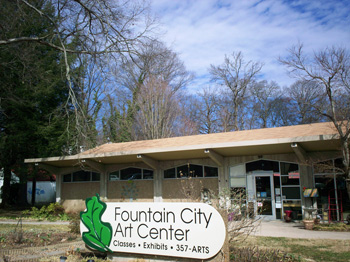
 I did not attend Fountain City’s funeral, but a friend told me about it later and said it was quite an event that ended with the playing of “Taps.” Actually, as a teenager, I didn’t notice much difference after we were annexed, except that we got street lights on our street, which was a positive effect to me. I lived in Fountain City from the time I was nine until I got married and left, so I consider it my hometown. This trip was a sentimental journey for me.
I did not attend Fountain City’s funeral, but a friend told me about it later and said it was quite an event that ended with the playing of “Taps.” Actually, as a teenager, I didn’t notice much difference after we were annexed, except that we got street lights on our street, which was a positive effect to me. I lived in Fountain City from the time I was nine until I got married and left, so I consider it my hometown. This trip was a sentimental journey for me.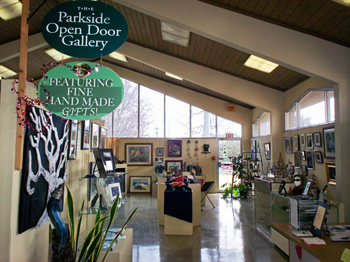 I remembered when I lived there that the building was home to the Fountain City Library. The Center was in-between main exhibits when we were there, but two new exhibits are now on display. The Knoxville Book Arts Guild and the Southern Appalachian Photography Society will be on view until April 8. Student exhibits from different area schools are also exhibited in the Center. There were some excellent works from middle school students on display when we were there.
I remembered when I lived there that the building was home to the Fountain City Library. The Center was in-between main exhibits when we were there, but two new exhibits are now on display. The Knoxville Book Arts Guild and the Southern Appalachian Photography Society will be on view until April 8. Student exhibits from different area schools are also exhibited in the Center. There were some excellent works from middle school students on display when we were there. The eight-acre park now has lots of colorful playground equipment in addition to the swings and slides that were there when I was a youngster. Unlike some playgrounds, it seems to get a lot of use during good weather. The park is also now circled by a paved walking path, with freestanding “porch swings” scattered along the trail where you can sit and rest and watch the people and look at the old trees and the natural spring which flows through the park into First Creek. Fountain City Park is not owned by the City of Knoxville, but is owned, operated and maintained by the Fountain City Lion’s Club. The Lion’s Club Building is in the park and can be rented for meetings. My late father was a member of the club and we held his eightieth birthday party there.
The eight-acre park now has lots of colorful playground equipment in addition to the swings and slides that were there when I was a youngster. Unlike some playgrounds, it seems to get a lot of use during good weather. The park is also now circled by a paved walking path, with freestanding “porch swings” scattered along the trail where you can sit and rest and watch the people and look at the old trees and the natural spring which flows through the park into First Creek. Fountain City Park is not owned by the City of Knoxville, but is owned, operated and maintained by the Fountain City Lion’s Club. The Lion’s Club Building is in the park and can be rented for meetings. My late father was a member of the club and we held his eightieth birthday party there.
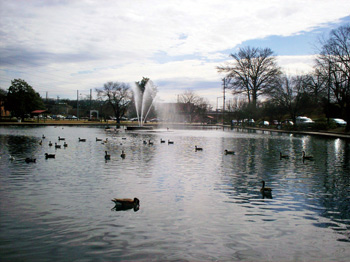 Before going to Litton’s, we walked around the block of Hotel Avenue and crossed the street to Fountain City Lake, also known as the duck pond. The lake was constructed around 1890. Designed by civil engineer F.G. Phillips, the heart-shaped body of water features a large fountain in the center gushing water skyward. We walked all around the lake, being careful to watch where we stepped. There were families there feeding the ducks, young couples and older couples strolling around, and even a couple of men fishing, and lots and lots of ducks.
Before going to Litton’s, we walked around the block of Hotel Avenue and crossed the street to Fountain City Lake, also known as the duck pond. The lake was constructed around 1890. Designed by civil engineer F.G. Phillips, the heart-shaped body of water features a large fountain in the center gushing water skyward. We walked all around the lake, being careful to watch where we stepped. There were families there feeding the ducks, young couples and older couples strolling around, and even a couple of men fishing, and lots and lots of ducks.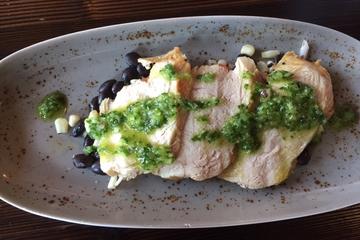
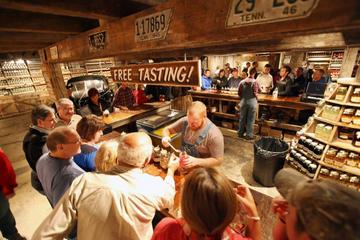

 The Columbian Star is number one on the trail and is the most impressive place on the tour, the Rhea County Courthouse at 1475 Market Street. The Courthouse was built in 1891 and designated as a National Historic Landmark in 1977. Still operated as a courthouse, it also houses the Scopes Trial and Rhea Heritage Museums with exhibits, photos, and news clippings of the famous trial. Dayton won its place in history when William Jennings Bryan and Clarence Darrow argued the question of evolution and creation in the Scopes Evolution Trial which took place at the courthouse in July 1925. We’ve all heard about the trial and may have seen the movie, “Inherit the Wind,” that was made about it, therefore, it is interesting to tour the museum and think about that hot summer many years ago and the debate about the origin of man which continues even today.
The Columbian Star is number one on the trail and is the most impressive place on the tour, the Rhea County Courthouse at 1475 Market Street. The Courthouse was built in 1891 and designated as a National Historic Landmark in 1977. Still operated as a courthouse, it also houses the Scopes Trial and Rhea Heritage Museums with exhibits, photos, and news clippings of the famous trial. Dayton won its place in history when William Jennings Bryan and Clarence Darrow argued the question of evolution and creation in the Scopes Evolution Trial which took place at the courthouse in July 1925. We’ve all heard about the trial and may have seen the movie, “Inherit the Wind,” that was made about it, therefore, it is interesting to tour the museum and think about that hot summer many years ago and the debate about the origin of man which continues even today.
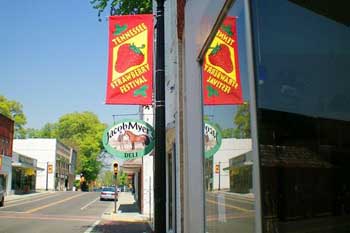 The second star on the tour is at 1435 Market Street. It was the second location of Robinson Drugstore. Built in the early 1900’s, it is currently home to The Gathering Place, appropriately named, as Robinson’s being a favorite gathering place for local citizens in the 1920’s seems to have been key to the whole Scopes trial. The Gathering Place is now an antique and gift store.
The second star on the tour is at 1435 Market Street. It was the second location of Robinson Drugstore. Built in the early 1900’s, it is currently home to The Gathering Place, appropriately named, as Robinson’s being a favorite gathering place for local citizens in the 1920’s seems to have been key to the whole Scopes trial. The Gathering Place is now an antique and gift store. The strawberry is far from Rhea County’s top crop, but the Dayton festival has preserved its heritage as the place for strawberries. Most of the berries for the event are furnished by Tidwell’s Berry Farm, the only large scale berry farm in the county. According to a Herald-News story, Ray Tidwell started his tiny farm near Spring City in 1983 growing corn and soybeans, but the farm flopped. An agriculture extension agent suggested he grow strawberries. At the time, there were only three acres of berries growing in the county. Doubting it would work, Tidwell gambled on the berries and it paid off. He now harvests 16 acres, each yielding about 20,000 pounds of strawberries. Tidwell doesn’t ship his berries across the country, but has turned his name into a popular regional brand. About 80 percent of his crop is sold from a shed at the farm on Hwy. 27, about 14 miles north of Dayton. If you can’t make it to the festival, you can still drive to Dayton during strawberry season to follow the town’s history with the Appalachian Quilt Block Stars and stop at Tidwell’s to buy fresh strawberries on your way home.
The strawberry is far from Rhea County’s top crop, but the Dayton festival has preserved its heritage as the place for strawberries. Most of the berries for the event are furnished by Tidwell’s Berry Farm, the only large scale berry farm in the county. According to a Herald-News story, Ray Tidwell started his tiny farm near Spring City in 1983 growing corn and soybeans, but the farm flopped. An agriculture extension agent suggested he grow strawberries. At the time, there were only three acres of berries growing in the county. Doubting it would work, Tidwell gambled on the berries and it paid off. He now harvests 16 acres, each yielding about 20,000 pounds of strawberries. Tidwell doesn’t ship his berries across the country, but has turned his name into a popular regional brand. About 80 percent of his crop is sold from a shed at the farm on Hwy. 27, about 14 miles north of Dayton. If you can’t make it to the festival, you can still drive to Dayton during strawberry season to follow the town’s history with the Appalachian Quilt Block Stars and stop at Tidwell’s to buy fresh strawberries on your way home.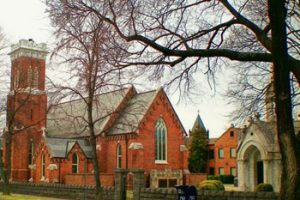
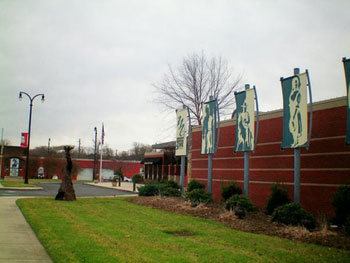 When I visited, I headed first to The Museum Center at Five Points, a regional history museum with exhibitions, a store, and programs related to the history of Cleveland, Bradley County, and the Ocoee Region of Tennessee. The museum is located at 200 Inman Street East. The core exhibition uses the theme, River of Time, to trace the history of the area. This theme signifies the importance of the Ocoee, Hiwassee and Tennessee Rivers to the region.
When I visited, I headed first to The Museum Center at Five Points, a regional history museum with exhibitions, a store, and programs related to the history of Cleveland, Bradley County, and the Ocoee Region of Tennessee. The museum is located at 200 Inman Street East. The core exhibition uses the theme, River of Time, to trace the history of the area. This theme signifies the importance of the Ocoee, Hiwassee and Tennessee Rivers to the region. Glass etchings in the lobby depict visual images of living history characters that visitors may watch on videos while walking through the displays. These characters introduce seven time periods, from Coming to the Land (Prehistory-1804) thru Paths to the Future (1979-Present,) while artifacts represent the different times. A real wagon that came to Bradley County with settlers in 1839 can be seen as well as a kayak from the 1996 Olympic Canoe and Kayak Competition on the Ocoee River. There are also hands-on stations throughout for kids to enjoy.
Glass etchings in the lobby depict visual images of living history characters that visitors may watch on videos while walking through the displays. These characters introduce seven time periods, from Coming to the Land (Prehistory-1804) thru Paths to the Future (1979-Present,) while artifacts represent the different times. A real wagon that came to Bradley County with settlers in 1839 can be seen as well as a kayak from the 1996 Olympic Canoe and Kayak Competition on the Ocoee River. There are also hands-on stations throughout for kids to enjoy.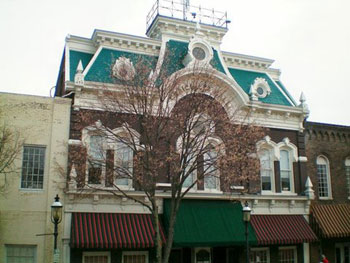 The Cleveland Public Library is housed in a home built in 1883. Originally about two-thirds the size of the present residence, the house was bricked and remodeled in 1940. In 1987, it became the library. A 5000-square-foot expansion began in 2001. Next door is the Carmichael Library Addition, another historic home recently donated to the library.
The Cleveland Public Library is housed in a home built in 1883. Originally about two-thirds the size of the present residence, the house was bricked and remodeled in 1940. In 1987, it became the library. A 5000-square-foot expansion began in 2001. Next door is the Carmichael Library Addition, another historic home recently donated to the library.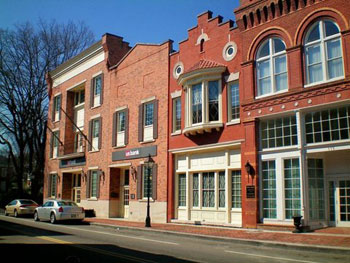
 The land that forms the town was originally part of Spencer County, North Carolina, and then it became part of the state of Franklin, then went back to North Carolina, and finally became part of Hawkins County, Tennessee. During the time Hawkins County was being shifted from one state to the other, it was for a while part of the Territory South of the River Ohio, and in 1791 the first newspaper in the Territory was printed. It was called the Knoxville Gazette and in 1792 was moved to Knoxville, the new capital of the Territory. Rogersville’s Tennessee Newspaper and Printing Museum reflects the area’s long involvement with the printing industry. It is located in the Southern Railway Train Depot. The Depot was built in 1890 and also houses the offices of the Rogersville Heritage Association. A centerpiece of the museum is the last linotype machine to be used to set type for a newspaper in Tennessee. It came from the Rogersville Review where it was used until l982. Many newspapers from Rogersville’s history, some original copies, some photocopies, are also on exhibit. The museum, at the corner of Depot and Broadway, is free but it is currently open limited hours and by appointment (423-272-1961).
The land that forms the town was originally part of Spencer County, North Carolina, and then it became part of the state of Franklin, then went back to North Carolina, and finally became part of Hawkins County, Tennessee. During the time Hawkins County was being shifted from one state to the other, it was for a while part of the Territory South of the River Ohio, and in 1791 the first newspaper in the Territory was printed. It was called the Knoxville Gazette and in 1792 was moved to Knoxville, the new capital of the Territory. Rogersville’s Tennessee Newspaper and Printing Museum reflects the area’s long involvement with the printing industry. It is located in the Southern Railway Train Depot. The Depot was built in 1890 and also houses the offices of the Rogersville Heritage Association. A centerpiece of the museum is the last linotype machine to be used to set type for a newspaper in Tennessee. It came from the Rogersville Review where it was used until l982. Many newspapers from Rogersville’s history, some original copies, some photocopies, are also on exhibit. The museum, at the corner of Depot and Broadway, is free but it is currently open limited hours and by appointment (423-272-1961).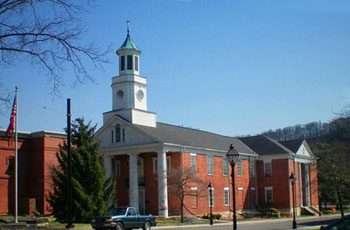 The Town Square is the center of downtown Rogersville and each corner of the square is a historic site. The Hawkins County Courthouse, built in 1836, is the oldest original courthouse still in use in the state. Just across from the Courthouse is the Masonic Temple, site of the oldest continually operating lodge in Tennessee, chartered in 1805. Overton Lodge #5 was named for Andrew Jackson’s law partner, John Overton. The building was built in 1839 as the first branch of the Bank of the State of Tennessee, which failed just after the Civil War because all its assets were in Confederate bonds and money. Kyle House and Hale Springs Inn are on the other corners of the square. The Kyle House was built in 1837 as a 22 room mansion for William Simpson. During the Civil War, Confederate officers and soldiers were housed there. Just across Main Street, Union officers and soldier were housed in the Hale Springs Inn.
The Town Square is the center of downtown Rogersville and each corner of the square is a historic site. The Hawkins County Courthouse, built in 1836, is the oldest original courthouse still in use in the state. Just across from the Courthouse is the Masonic Temple, site of the oldest continually operating lodge in Tennessee, chartered in 1805. Overton Lodge #5 was named for Andrew Jackson’s law partner, John Overton. The building was built in 1839 as the first branch of the Bank of the State of Tennessee, which failed just after the Civil War because all its assets were in Confederate bonds and money. Kyle House and Hale Springs Inn are on the other corners of the square. The Kyle House was built in 1837 as a 22 room mansion for William Simpson. During the Civil War, Confederate officers and soldiers were housed there. Just across Main Street, Union officers and soldier were housed in the Hale Springs Inn. The location of Hale Springs Inn has been the site of a public house since Daniel Hamblen purchased the lot in 1790 for helping Joseph Rogers lay out the town. On it he built a home which also served the fledgling town as a tavern. In 1824, John A. McKinney purchased the property and built a large brick building designed by John Dameron, also the architect of the Courthouse. The building included both a store and a hotel and became known as McKinney’s Tavern. The Inn changed hands and names several times through the years, and before it closed in 1999 was the oldest continuously run Inn in Tennessee. In 2003, the Rogersville Heritage Association bought the hotel and completely renovated it, keeping the original heart pine floor throughout and furnishing each room with colonial and American empire pieces, some original to the Inn. The inn has three presidential suites all named after presidents which have been previous guests: Andrew Jackson, Andrew Johnson, and James K. Polk. McKinney’s by Troutdale, the Inn’s dining room, serves contemporary southern cuisine and is open to the public for dining Tuesday through Saturday for lunch and dinner and Sunday brunch on holidays.
The location of Hale Springs Inn has been the site of a public house since Daniel Hamblen purchased the lot in 1790 for helping Joseph Rogers lay out the town. On it he built a home which also served the fledgling town as a tavern. In 1824, John A. McKinney purchased the property and built a large brick building designed by John Dameron, also the architect of the Courthouse. The building included both a store and a hotel and became known as McKinney’s Tavern. The Inn changed hands and names several times through the years, and before it closed in 1999 was the oldest continuously run Inn in Tennessee. In 2003, the Rogersville Heritage Association bought the hotel and completely renovated it, keeping the original heart pine floor throughout and furnishing each room with colonial and American empire pieces, some original to the Inn. The inn has three presidential suites all named after presidents which have been previous guests: Andrew Jackson, Andrew Johnson, and James K. Polk. McKinney’s by Troutdale, the Inn’s dining room, serves contemporary southern cuisine and is open to the public for dining Tuesday through Saturday for lunch and dinner and Sunday brunch on holidays.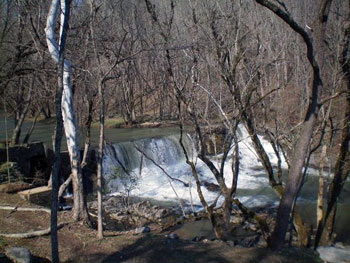 After lunch, I visited the Local Artists Gallery on Main Street. They have items for sale by local artists and craftsmen and next door is Mountain Star Mall which has primitive country décor, antiques, and gift items. I then drove about five miles northeast of Main Street to Amis Mill Eatery on Bear Hollow Road. I had heard that there was a waterfall across the road from it and knew that it was an on-site re-creation of the original facility built by Captain Thomas Amis. Amis built a fort, mill and dam in 1781 at Big Creek on the Great Indian Warpath Trail (later Old Stage Road) with the assistance of his friend and fellow Scots-Irishman John Carter. He then built a trading post, blacksmith shop, forge, distillery, tannery and eventually his home, which was used not only for his family but also to board and feed settlers and travelers. This was the last roof one could sleep under before heading into the wilderness and on into Kentucky. Daniel Boone frequented Amis while blazing the Cumberland Gap trail. One can see part of the stone foundation of the original Amis Mill beside the creek.
After lunch, I visited the Local Artists Gallery on Main Street. They have items for sale by local artists and craftsmen and next door is Mountain Star Mall which has primitive country décor, antiques, and gift items. I then drove about five miles northeast of Main Street to Amis Mill Eatery on Bear Hollow Road. I had heard that there was a waterfall across the road from it and knew that it was an on-site re-creation of the original facility built by Captain Thomas Amis. Amis built a fort, mill and dam in 1781 at Big Creek on the Great Indian Warpath Trail (later Old Stage Road) with the assistance of his friend and fellow Scots-Irishman John Carter. He then built a trading post, blacksmith shop, forge, distillery, tannery and eventually his home, which was used not only for his family but also to board and feed settlers and travelers. This was the last roof one could sleep under before heading into the wilderness and on into Kentucky. Daniel Boone frequented Amis while blazing the Cumberland Gap trail. One can see part of the stone foundation of the original Amis Mill beside the creek.